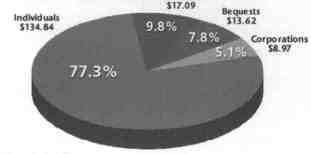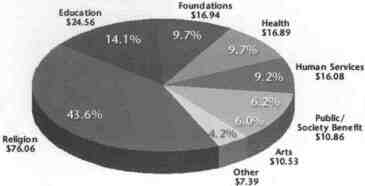SPECIAL FOCUS
The Giving Season
JOHN W. COMERIO, CLP
is the development director for the Illinois Association of Park
Districts and manager or Friends of Illinois Panes, lAPD's nonprofit
organization established in 1998 to involve more
citizens in their local park district and forest
preserves. Comerio received his certification as a
fund-raising manager from the Fund Raising School
at Indiana University, Center of Philanthropy. He
can be reached at 217.523.4554 or
iapd@eosinc.com.
Some say philanthropy is the future of parks and recreation,
and this fund-raiser agrees
BY JOHN W. COMERIO, CLP
|
We make a living
by what we get,
but we make a life by what we give."
-Winston Churchill
|
'T is the giving season in more ways than one. Yes,
we are fast approaching the holidays, when people give
to friends and family...and to charities. (Those end-of-
the-year write-offs can benefit a particular cause as
well as an individual's bottom line.)
At this time, too, society's giving spirit is particularly aimed at nonprofit organizations, which could
include public park districts, forest preserves and
their fund-raising arms. In fact, giving to nonprofit
organizations is at an all-time high. Americans
contributed a record $174.52 billion to nonprofits in
1998, according to "Giving
USA 1999," a report
published by the American
Association for Fund
Raising Counsel
(AAFRC) Trust for
Philanthropy.
This kind of
generosity comes at
an opportune time
for park districts, forest
preserves, recreation and natural
resource agencies.
"Do more with what you've got" is the mantra of
our citizenry, and every agency hears it.
|

|
According to a recent economic assessment survey
by the Illinois Association of Park Districts, member
districts need more funds and more resources to satisfy
local demands for facilities, open space and recreational programming. While asking for more and
expecting the best from their public park and recreation agencies, taxpayers don't like tax increases. They
see "tax caps" as a way to protect their income. And,
already these agencies are realizing 50 percent or more
of their annual operating income from fees and
charges.
|
Savvy taxpayers, however, are also looking for ways
to reduce their personal taxes and ways to direct their
social capital. Districts can help these taxpayers and
themselves by taking advantage of "the giving season."
Who gives what?
For the first time since 1972, giving to charity
exceeded two percent of the gross domestic product.
Revenues to all four sources tracked (individuals,
bequests, foundations and corporations)
increased during 1998.
Personal giving by
living individuals
continues to represent
the vast majority of
charitable contributions.
More than 77 percent of
todays giving comes from
individuals who contribute nearly $135 billion, a
10 percent increase over
the past reporting year. (See
"Sources of Contribution" pie chart on page 29.)
Giving by bequest, a gift of personal property by
will, continues to increase, hitting $13.6 billion in
1998.
Corporate giving for 1998 was at $8.9 billion from
over 5.1 percent of the contributors.
Foundations weighed in as the second highest
source of contributions at $17.1 billion from 9.8
percent of the donors.
November/December 1999 /23
|
Illinois Giving
According to national statistics
compiled for 1996 by the Foundation
Center, there were 41,588 foundations
in the United States with grant-making
of nearly $14 billion and assets of $267
billion. Six percent of all U.S. foundations are located in the state of Illinois.
Illinois ranked as the fourth largest state
in the country in terms of the number
of foundations within its borders and
fifth in terms of total annual grant inakitig.
Illinois accounted for 5.5% of all U.S.
grant-making and 5% of all foundation
assets.
Of the top U.S. foundations, Illinois is
home to:
four of the largest corporate
foundations (by grant-making
activity).
six of the largest corporate
foundations (by asset size).
three of the largest independent
foundations (measuring both
grants and assets).
According to national tax return figures,
taxpayers in Illinois claimed $3.888
billion in charitable contributions in
1996. Applying the Giving USA
methodology, the $3.888 billion in
individual giving accounted for 80% of
all individual philanthropy. Illinois
individual giving can be estimated at
$4.75 billion.
Illinois ranked fifth compared to rest of
states in terms of total dollars claimed
by charitable contributions.
The average contribution by Illinois
taxpayers who took a charitable
deduction was $2,637 per return,
slightly below the national average of
$2,698.
According to 1997 data, there were
1,933 foundations and corporate giving
programs in Illinois with total assets
of $ 16.2 billion and total annual
grant-making of $917 million.
Illinois ranked fifth in the nation for
its grant-making activity, followed by
New York, California, Pennsylvania
and Michigan.
Chiicagoland Funders
One out of every two grants made by a
Chicago-area foundation was under
$10,000. Fifteen percent of the grants
were for $50,000 or more.
The majority of grant dollars reported
by Chicago-area funders (44%)
benefitted national organizations
outside Illinois; a nearly equal amount
of funding (42%) supported Chicago-
based organizations and recipients.
One in ten philanthropic dollars
supported arts organizations, with two-
thirds of this amount going to Illinois-
based arts organizations and artists.
Education received the largest share of
local philanthropic resources; half of
this support went to Illinois-based
schools, educational organizations and
programs.
Environmental issues were a major
focus for family and private independent foundations; though the majority
of these resources (80%) supported
organizations outside Illinois.
Human services ranked first, based on
the total dollars awarded, funded by
these types of foundations: community
and family foundations and corporate
funders.
Compared to the nation, local funders
awarded twice the amount of research
dollars and significantly less for
capitol support.
"Giving in Illinois," Donors forum of Chicago
|
Who gets the money?
Organized religion dominates for
contributions by type with nearly 44
percent of the funding at $76 billion. (See
second pie chart on page 29.) Nonprofits
that are more directly or traditionally
aligned with parks, recreation, arts, natural
resources, wildlife or the environment also
represent a significant percentage of the
recipients. For example, the category
"other" includes environment/wildlife
organizations receiving $5.25 billion.
In addition, giving to foundations
($16.94 billion), along with arts ($10.53
billion), public/society benefits ($10.86
billion), provided a combined total of
$43.5 billion from nearly 25 percent of all
inventoried sources. Each of these four
recipient categories represent potential gift
sources or leads for your fund-raising arm
or your agency.
The "Sources of Contribution" pie chart
is especially revealing. A commonly held
belief is that corporations are the best or
greatest source of giving to nonprofits.
Many Illinois-based corporations are, in
fact, generous through direct giving,
workplace giving, as well as in-kind
contributions through their marketing,
community relations and advertising
budgets. Park districts, forest preserve
districts and conservation districts have
come to rely on corporate giving and
corporate sponsorships for major events,
activities, programs and facility development.
Giving by individuals is the real story.
All sources and research to date report the
same significant finding: the preponderance of giving comes from individuals.
Thus, personal giving remains the most
potent force for park and recreation
agencies to tap into.
Nancy Raybin, chair of the AAFRC
Trust for Philanthropy, believes nonprofit
organizations should strike a balance
between raising money from individuals
and foundations.
According to Raybin: "Individuals have
more capacity to give than foundations do,
and their capacity has not yet been
unleashed at its highest possible level."
How do you get the money?
Park districts and forest preserves can
take advantage of all this generosity in
ways that are appealing and attractive to
donors while meeting the community's
needs. Here are several ways to do this.
Dedicate a staff member to corporate
sponsorship of agency programs, events
and facilities. Champaign Park
District's "Partner in Parks," a
corporate sponsorship program, to
date has raised $115,000 for park
projects.
Hire a development officer to garner
funds from nontraditional sources. This
is becoming increasingly popular
among park and recreation agencies.
The Deerfield, Barrington and Skokie
park districts are realizing success from
the creative efforts of their development directors to secure funds.
Create a "friends" affiliate organization
focused on a specific district need.
Homewood-Flossmoors friends group
launched a "Save the Auditorium"
campaign, which realized $72,000 for
an important district facility.
The 501(c)3
Another popular approach used by
districts across Illinois is a 501(c)3
nonprofit corporation. We know the
American public is extremely generous as
evidenced by the statistics on giving.
Generally speaking, individuals do not like
to give to government for specific causes.
Many believe they give enough to
government in the form of taxes.
Establishing a nonprofit corporation
offers distinct advantages to the district
and, in turn, to potential donors. The
advantages of a nonprofit corporation
include:
Ability to focus community support
for an identified mission.
Leadership by a governing board of
individuals interested in the mission,
financially able to give and influential,
so that others follow their lead.
Can supply and apply their resources
directly to identified purposes and
provide prudent stewardship of
resources.
24/ Illinois Parks and Recreations
Provides protection and identifies
limitations established by federal law.
Has a separate identity with an
independent, accountable governance
board.
Allows assets to be protected from
potential litigation against the district
(a corporate veil).
Allows gifts like cash, investments,
securities, endowments, planned gift
instruments (life estates, memorial
gifts, trusts, and donations of land) to
be managed by the corporation or its
agent.
Provides opportunities for forging new
partnerships and alliances in and
outside the community or district.
Enhances the district's ability to solicit
and garner community support.
Allows donor contributions to be tax-
deductible, within limits identified by
the Internal Revenue Code.
Creating a nonprofit organization,
however, does not automatically ensure
success. When considering establishing a
501(c) 3, be aware of other considerations
The nonprofit must have a
mission that prospective
donors can relate to, find of
interest and wish to support.
People do not give to causes,
but rather they give to people
with causes; hence, the need
for dedicated and committed
leadership to direct the
nonprofit.
Brick and mortar projects are
very popular and successful.
In contrast, fund-raising
efforts to increase operating
expenses often are very
difficult to market.
|
Giving 1998: $ 174.52 Billion

Note :$'s in billions
Source : Giving USA 1999 / AAFRC Trust for Philanthropy
|
Giving 1998

Note: Percentages represent "allocated" giving and add to more than 100%.
"Other" includes Environment/Wildlife, $5.25 (3.0%), and International Affairs, $2,14 (1.26%).
Source : Giving USA 1999 / AAFRC Trust for Philanthropy
|
In Illinois, 54 park districts
and forest preserves have a
"Friends" group or foundation,established to benefit the mission of their
organization. Some of those organizations
have separate governing boards. In several
cases, the district trustees are also directors
of the foundation board. Not all of these
supporting organizations are designated501(c)3 nonprofit corporations.
Some of the nonprofits are more
successful than others. Typically, those less
successful lack a focused mission or a
passionate leader. Those with a limited,
identified and established purposefor
November/December 1999 /25
example, a museum, nature preserve or
zoo are realizing success.
Each district or community must
identify its long-term needs and the best
course of action to address its future and
the challenges that lie ahead. Supporting
organizations, particularly a nonprofit
501(c)3 corporation, oner considerable
advantages and possibly untapped sources
for your district.
And what better time than this, the
giving season, to consider a fund-raising
program for your agency.
26/ Illinois Parks and Recreation


